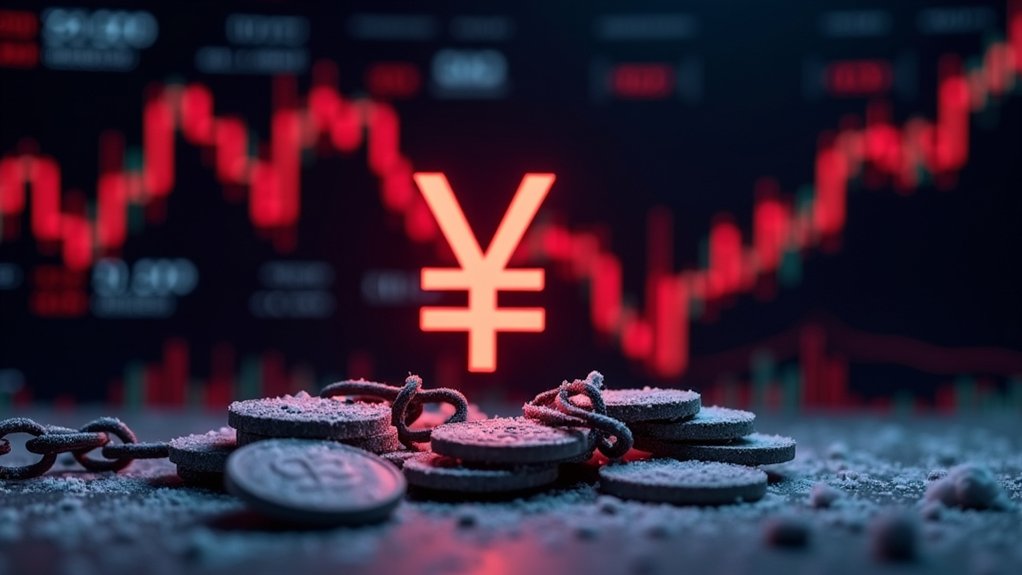Exchange-traded funds (ETFs) work like baskets that hold different investments, such as stocks and bonds, all bundled into one package that trades on the stock market. They’re similar to mutual funds but can be bought and sold throughout the trading day at varying prices. ETFs typically charge lower fees than mutual funds and are managed by professionals who track specific market indexes. The creation and redemption process helps keep ETF prices aligned with their actual value. There’s much more to discover about these versatile investment vehicles.
Quick Overview
- ETFs are investment funds that hold multiple securities like stocks or bonds, allowing investors to own a diversified portfolio through a single purchase.
- Similar to stocks, ETFs trade on exchanges throughout the day with prices determined by market supply and demand.
- ETFs typically charge lower fees than mutual funds because they passively track market indices rather than actively managing investments.
- Authorized Participants maintain ETF market efficiency by creating or redeeming shares in exchange for underlying securities.
- ETFs offer various investment options, from broad market indices to specific sectors, providing flexibility for different investment strategies.

While many people invest in individual stocks, Exchange-Traded Funds (ETFs) offer a simpler way to own multiple investments in one package. ETFs are investment funds that hold a collection of stocks, bonds, or other securities all bundled together. They’re designed to track how well a specific market index or asset performs. When investors buy ETF shares, they don’t actually own the underlying assets – instead, they own a piece of the fund itself. Most ETFs use a passive management approach, keeping costs lower for investors.
ETFs work similarly to stocks when it comes to trading. They’re bought and sold on stock exchanges throughout the trading day, and their prices change based on supply and demand. Over 380 ETF options are now available to investors across Australian exchanges. Investors can purchase ETF shares through their regular brokerage accounts, just like they would with individual stocks. One advantage of ETFs is that they often charge lower fees compared to mutual funds, making them cost-effective for many investors. The global ETF market has grown tremendously, with assets under management exceeding $10 trillion.
Behind the scenes, ETFs operate through a unique process called creation and redemption. Special financial institutions, known as Authorized Participants (APs), work with ETF providers to create or remove ETF shares from the market. These APs exchange baskets of the underlying securities for large blocks of ETF shares. This process helps keep the ETF’s price closely aligned with its actual value and reduces tracking errors.
ETFs come in different varieties to suit different investment approaches. Passive ETFs simply follow specific market indices, like the S&P 500, while active ETFs have managers who try to beat market benchmarks through strategic trading. There are also thematic ETFs that focus on specific industries or trends, like technology or renewable energy. Some specialized ETFs use financial derivatives to create leveraged or inverse returns, though these are typically more complex.
Professional investment advisers manage ETFs, ensuring they follow regulatory requirements set by the Investment Company Act of 1940. These managers handle the day-to-day operations of the fund, including buying and selling securities to maintain the fund’s investment strategy. The fund managers also work to minimize tracking error, which is the difference between the ETF’s performance and its target index or asset.
ETFs offer investors a way to access various asset classes, from stocks and bonds to commodities. They provide intraday liquidity, meaning investors can buy or sell their shares whenever the market is open, unlike mutual funds which only trade once per day. This flexibility, combined with their diversified nature and generally lower costs, has made ETFs increasingly popular among investors.
Frequently Asked Questions
What Happens to My ETF Investment if the Fund Company Goes Bankrupt?
If a fund company goes bankrupt, an investor’s ETF holdings remain safe.
That’s because ETFs are structured as separate legal entities, and their assets are held by independent custodians, not the fund company itself.
The assets can’t be touched by the bankrupt company’s creditors.
In most cases, another fund company will take over management of the ETF, or investors will receive the current market value of their shares.
Can I Invest in ETFS Through My Retirement Account or IRA?
Investors can typically hold ETFs in their retirement accounts, including traditional and Roth IRAs.
Many 401(k) plans now offer ETFs as investment options alongside mutual funds.
These investment vehicles are becoming more common in retirement accounts because they’re often less expensive than mutual funds and can help with diversification.
The specific ETFs available will depend on what’s offered through someone’s retirement plan or the brokerage firm managing their IRA.
How Often Do ETFS Pay Dividends to Investors?
ETFs pay dividends at different times throughout the year. Most ETFs distribute dividends every three months (quarterly), but some pay monthly or yearly.
It depends on the type of ETF and who manages it. For example, bond ETFs often make monthly payments, while stock ETFs typically pay quarterly.
The payment schedule isn’t random – it’s set by the ETF company and listed in the fund’s official documents.
Are ETFS Safer Than Individual Stocks During Market Downturns?
ETFs are generally considered safer than individual stocks during market downturns. This is because ETFs spread investments across many different companies, while individual stocks put all the risk in one company.
When markets fall, ETFs typically don’t drop as sharply as individual stocks can. However, ETFs aren’t completely safe – they’ll still go down when the market falls, just usually not as dramatically as single stocks might.
What’s the Minimum Amount of Money Needed to Start Investing in ETFS?
The minimum amount needed to invest in ETFs can be as low as $1 with brokers that offer fractional shares.
Without fractional shares, investors need enough money to buy at least one full share, which varies by ETF. Share prices range from under $50 to hundreds of dollars per share.
Many popular brokers like Fidelity, Schwab, and Vanguard don’t require large minimum investments, and some offer commission-free ETF trading.





